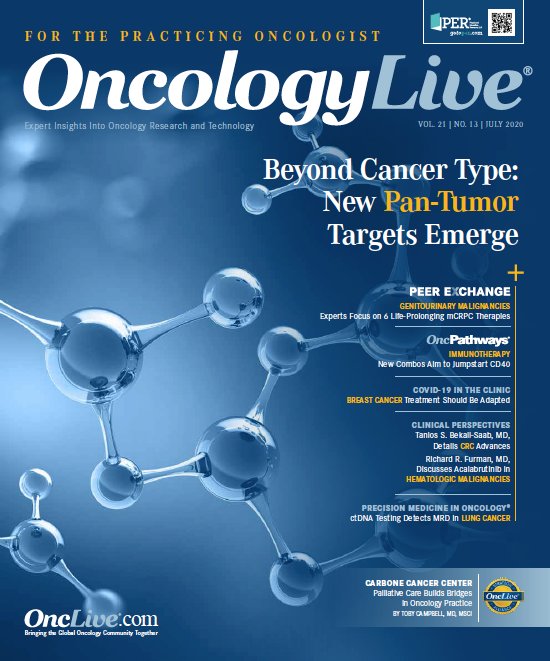Publication
Article
Palliative Care Builds Bridges in Oncology Practice
Author(s):
Toby Campbell, MD, MSCI, discusses the nuances of palliative care in oncology.
Toby Campbell, MD, MSCI

Pamina, a woman aged 67 years with metastatic non–small cell lung cancer, has received 6 prior lines of therapy. She has maintained an excellent performance status with a low-to-moderate disease burden. Her goals are to live longer but also to continue to receive chemotherapy. “I’ve got to be fighting. I’m not someone who could just sit around and wait to die,” she has said. As her oncologist, I have discussed with her the statistical improbability that anyone receiving therapy in the fourth line and beyond derives a survival benefit, and she has participated in at least 3 clinical trials.
She has not tolerated prognostic discussions with me and brings the conversation right back to chemotherapy. I was worried that she really did not have good prognostic awareness; that lack of awareness, I thought, was driving her treatment decision-making toward more therapy, which was almost certainly not going to prolong her life. During a recent hospitalization, the inpatient palliative care team completed 2 visits with her and addressed her pain and shortness of breath; the team also confirmed that she has an accurate understanding of her disease and its prognostic implications. I found this information reassuring. It also confirmed my suspicions that for both my patients and for myself, the divide between oncology and palliative care is a difficult one to bridge.
As oncologists, we face extraordinary patient care challenges that cross physical, behavioral, emotional, psychological, and existential boundaries. At the same time, our profession challenges us to understand and engage with policy and politics, medicine and surgery, insurance and pharmaceuticals. We care for patients and families when they are at their most vulnerable, and we see the toll that stress takes on a group of individuals.
We helm infrastructure at our respective hospital systems that generates activity across the organization, and we feel the pressure and responsibility to keep the engine turning. It is easy to get caught up in the inertia of our lives. Oncologists have a difficult job with many, sometimes conflicting, expectations and responsibilities. It is not a surprise that nearly half of our workforce is dealing with substantial levels of burnout.1
As a thoracic oncologist, I practice state-of-the-art medical oncology at a quaternary referral center; it is the comprehensive cancer center of the flagship university in our proud statewide system of colleges, The University of Wisconsin—Madison. I am also a fellowship-trained palliative care clinician who spent nearly a decade as a fellowship program director. My palliative care practice is primarily in the inpatient setting, where I see patients with myriad diagnoses and clinical situations for symptom management, complex decision-making, end-of-life care, and any number of other complicated needs.
Despite my training and experience, I am almost completely incapable of practicing as both a thoracic medical oncologist and a palliative care physician simultaneously. The sets of skills necessary for both roles while related, are far too distinct to do either justice in a single clinical encounter. As palliative care services become more routinely available to patients in the cancer clinic,2 many oncologists ask, “What are you doing that I’m not already doing? Why would my patients need additional services? How are you going to help me and my patients?”
Primary Palliative Care
My work with patients includes chemotherapy treatment considerations, response assessments, and other complex safety and efficacy considerations. Additionally, some domains have crossover with those also addressed by the palliative care team members, including symptom management, goals of care, advanced care planning, and treatment decision-making.
We are routinely practicing primary palliative care, particularly in scan visits, where we are delivering news with prognostic implications, and in treatment decisionmaking visits, where we are evaluating goals and values. Although the domains may be similar, there is relatively little overlap between the work an oncologist does with the patient and that of the palliative care clinician.3 Perhaps the extra time, attention, and expertise our colleagues bring to the exam room is why our patients who are also seen for palliative care have improved symptom burden and quality of life, enhanced coping skills, and prolonged survival.4,5
Understanding When to Introduce Secondary Palliative Care
Assessing the coping skills of patients and their families, and helping them further develop those skills as they acquire prognostic awareness, is developing into a critical area the palliative care clinician brings to the cancer clinic.6 This includes the ability of the clinician to recognize and react to the natural vacillation that happens with patients like Pamina as they swing between moments of full awareness and preparation for end-of-life care, as she did with the palliative care team, and moments where she may seem to reject the notion that her life is under threat, as she usually does with me.7
Referral Criteria
Given my realization that, as a dual-trained oncology and palliative care physician, I am unable to simultaneously provide both skill sets to my patients, I refer many of my patients to the palliative care team for early and integrated care. I routinely refer patients with metastatic disease as well as patients with challenging symptoms, substance abuse disorders, limited coping skills, or limited social support.
I also make referrals any time I think the patient or family would benefit from additional time with a clinician, someone who is able to focus on helping them integrate the reality of being a patient with cancer with all the other roles in their life. I find my stress level measurably lower when I am able to rely on my colleagues to provide palliative care, leaving me to focus on the complex task of safely delivering cancer care. I find the integrated oncopalliative care practice to be good for me, my patients, their families, and our health care system.
References
- Hlubocky FJ, Spence R, McGinnis M, et al. Burnout and moral distress in oncology: taking a deliberate ethical step forward to optimize oncologist well-being. JCO Oncol Pract. 2020;16(4):185-186. doi:10.1200/OP.20.00030
- Heitner R, Rogers M, Meier DE. Mapping Community Palliative Care: A Snapshot. Center to Advance Palliative Care; 2019. Accessed June 17, 2020. bit.ly/31gRJ1M
- Yoong J, Park ER, Greer JA, et al. Early palliative care in advanced lung cancer: a qualitative study. JAMA Intern Med. 2013;173(4):283-290. doi:10.1001/jamainternmed.2013.1874
- Temel JS, Greer JA, El-Jawahri A, et al. Effects of early integrated palliative care in patients with lung and GI cancer: a randomized clinical trial. J Clin Oncol. 2017;35(8):834-841. doi:10.1200/JCO.2016.70.5046
- Temel JS, Greer JA, Muzikansky A, et al. Early palliative care for patients with metastatic non-small-cell lung cancer. N Engl J Med. 2010;363(8):733-742. doi:10.1056/NEJMoa1000678
- Greer JA, Jacobs JM, El-Jawahri A, et al. Role of patient coping strategies in understanding the effects of early palliative care on quality of life and mood. J Clin Oncol. 2018;36(1):53-60. doi:10.1200/JCO.2017.73.7221
- Jackson VA, Jacobsen J, Greer JA, et al. The cultivation of prognostic awareness through the provision of early palliative care in the ambulatory setting: a communication guide. J Palliat Med. 2013;16(8):894-900. doi:10.1089/jpm.2012.0547









